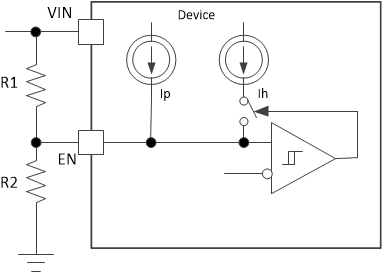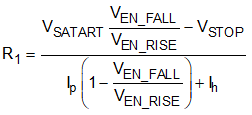SLVSEI2A November 2018 – May 2019 TPS56339
PRODUCTION DATA.
- 1 Features
- 2 Applications
- 3 Description
- 4 Revision History
- 5 Pin Configuration and Functions
- 6 Specifications
-
7 Detailed Description
- 7.1 Overview
- 7.2 Functional Block Diagram
- 7.3
Feature Description
- 7.3.1 Advanced Emulated Current Mode Control
- 7.3.2 Enable and Adjusting Undervoltage Lockout
- 7.3.3 Soft Start and Pre-Biased Soft Start
- 7.3.4 Voltage Reference
- 7.3.5 Minimum ON-time, Minimum OFF-time and Frequency Foldback at Dropout Conditions
- 7.3.6 Overcurrent and Undervoltage Protection
- 7.3.7 Thermal Shutdown
- 7.4 Device Functional Modes
- 7.5 Light-Load Operation
- 8 Application and Implementation
- 9 Power Supply Recommendations
- 10Layout
- 11Device and Documentation Support
- 12Mechanical, Packaging, and Orderable Information
Package Options
Mechanical Data (Package|Pins)
- DDC|6
Thermal pad, mechanical data (Package|Pins)
Orderable Information
7.3.2 Enable and Adjusting Undervoltage Lockout
The EN pin provides electrical on and off control of the device. When the EN pin voltage exceeds the threshold voltage, the TPS56339 begins operation. If the EN pin voltage is pulled below the threshold voltage, the regulator stops switching and enters the shutdown mode.
The EN pin has an internal pull-up current source which allows the user to float the EN pin to enable the device. If an application requires control of the EN pin, use open-drain or open-collector output logic to interface with the pin.
The TPS56339 implements internal undervoltage-lockout (UVLO) circuitry on the VIN pin. The device is disabled when the VIN pin voltage falls below the internal VIN UVLO threshold. The internal VIN UVLO threshold has a hysteresis of 510 mV.
If an application requires a higher UVLO threshold on the VIN pin, the EN pin can be configured as shown in Figure 15. When using the external UVLO function, setting the hysteresis at a value greater than 510 mV is recommended.
The EN pin has a small pull-up current, Ip, which sets the default state of the EN pin to enable when no external components are connected. The pull-up current is also used to control the voltage hysteresis for the UVLO function because it increases by Ih when the EN pin crosses the enable threshold. Use Equation 1 , and Equation 2 to calculate the values of R1 and R2 for a specified UVLO threshold. Once R1, R2 were settled down, the VEN voltage can be calculated by Equation 3, which should be lower than 5.5V with max VIN.
 Figure 15. Adjustable VIN Undervoltage Lockout
Figure 15. Adjustable VIN Undervoltage Lockout 


where
- Ip = 1.2 µA
- Ih = 3.1 µA
- VEN_FALL = 1.12 V
- VEN_RISE = 1.18 V
- VSATRT, the input voltage enabling the device
- VSTOP, the input voltage disabling the device